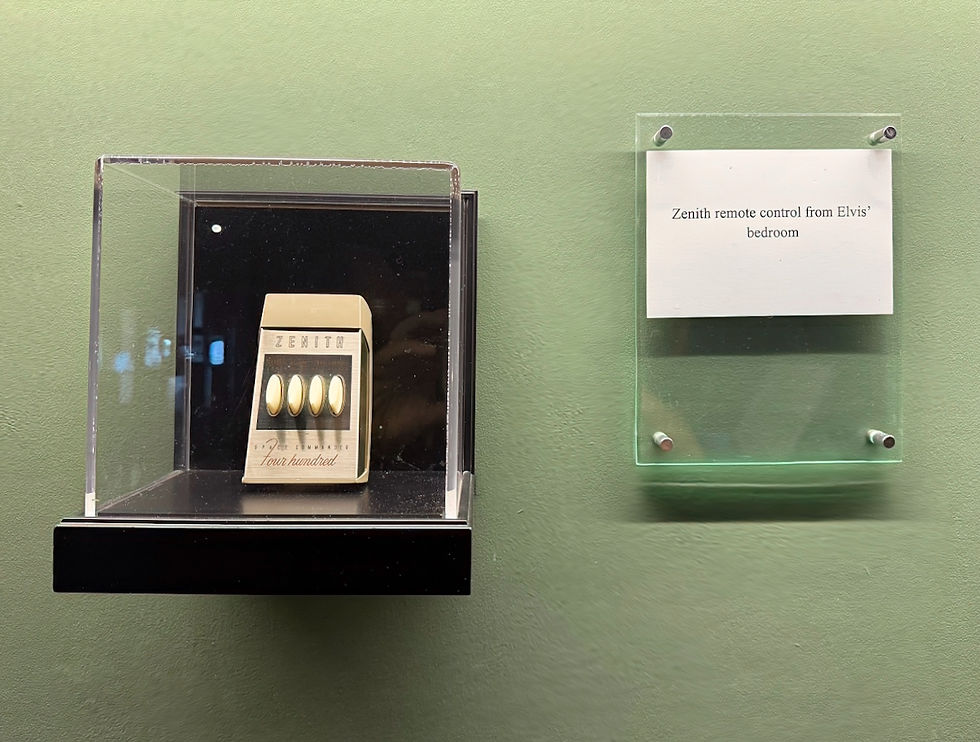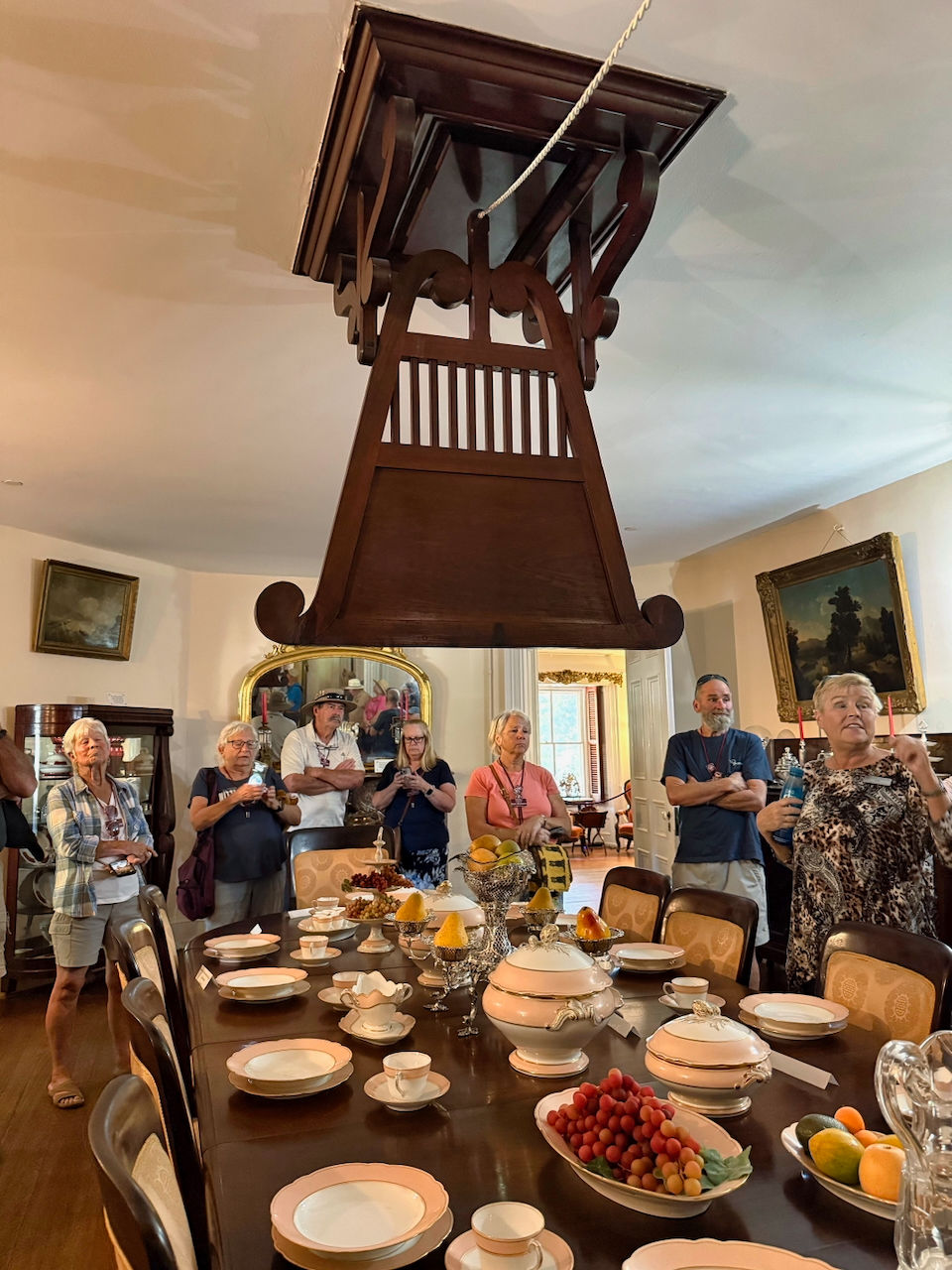The Great River Road: Memphis to New Orleans
- dougsmith51
- Oct 18
- 8 min read
We ended our last blog post in St. Louis, the halfway point of our trip down the Mississippi River. After a long driving day, we arrived in...
Memphis, TN
Caravan Adventures, our travel company, booked us into the campground across the street from Graceland. We'd stayed at the campground once before all the way back in 2019, our first year of RV travel.
Our first full day in town was a bus day and a rainy one (although we had been very lucky so far on the trip, with little rain and lots of warm weather). We traveled to the Rock N Soul Museum near FedEx Arena (where the Memphis Grizzlies NBA team plays). There, an audio tour took you through the history of first, blues, and then rock and roll as they grew out of the sharecropper experience and the popularization of "black music" when Elvis Presley brought it to white audiences.

After a lunch of BBQ, we visited the original location of Sun Studios (first named the Memphis Recording Service), where producer Sam Phillips discovered and popularized not only Elvis, but also artists such as Jerry Lee Lewis, Carl Perkins, Johnny Cash, and Roy Orbison.
The studio is still used after hours for recordings, and many famous artists of today have tried out this legendary studio.

A bus tour of the city after that took us past Memphis sites, including the Lorraine Motel.

We ended the afternoon at Memphis' Peabody Hotel where, at 5 pm, we watched the hotel's mallards march from the indoor fountain where they swim during the day out to the elevator and back to their roost on the hotel roof - a tradition that's been going on for almost 100 years. You may think this is not a big deal, but it is the Number 5 attraction in Memphis according to TripAdvisor.
The next morning we walked over from the campground and crossed Elvis Presley Boulevard to visit Graceland.

Elvis Presley bought the estate and house from a local doctor in the 1950s. It's still decorated as it was in the 60s and 70s, and most room are a bit kitchy as a result.
Other outbuildings on the property hold mementos and photographs. No artifact is too insignificant, such as Elvis' TV remote control.

Elvis is buried in the Meditation Garden outside the mansion, next to his parents.

Across the street are a number of museums, holding things such a Elvis' extensive car collection...
...exhibits on his time in the Army and on his manager Colonel Tom Parker, his gold records...

...his movie career...

...and his later career on TV and in Las Vegas.
Throughout the buildings there are multiple tributes to Elvis. He embodied the early days of Rock-and-Roll, was instrumental in bringing black music to white audiences, and inspired many later rockers.
The next day we traveled to The Pyramid, which was the city's basketball arenda until FedEx Arena was built, sat empty for a decade, and now is the site of a hotel and a large BassPro store.
An elevator in the center of the building takes you up to glass-bottom balconies that offer extensive views of downtown Memphis and the Mississippi River.
We had lunch at B.B. King's BBQ and club on Beale Street, once the home of many blues clubs.


We had a free afternoon, and took our e-bikes for a ride on the beautiful Shelby Farms Greenline trail.

Vicksburg, MS
We continued south to Vicksburg, which played a key role in the Civil War. The city sits high on a hill, and gun batteries were able to keep ships from moving up and down the Mississippi River.

Ulysses S. Grant initially tried to have troops attack the town from multiple sides, but the Confederates had the high ground. The entire battlefield is very hilly. Union casualties were high, and Confederate casualties were low.

The battlefield has more than 1,400 monuments of various sizes.

Ultimately, Grant decided to establish a siege of Vicksburg, forcing people to eat dogs, cats, and mules to survive. The Confederates surrendered on July 4, 1863 after 74 days.
After the initial battles, solders were buried in mass graves. Once the town fell to the Union, a national cemetery was established. There are headstones, but also many small stones marking the graves of unknown soldiers.

Union ironclads were able to run the river during the siege. One, the USS Cairo, was sunk by a mine, and sat on the bottom of the river for about 100 years before it was salvaged. It can be visited on the Vicksburg battlefield tour road.
We moved on to the town of Vicksburg itself, visiting the historic courthouse which survived Union shelling. It's now a museum.

We had time to walk around town, and visited a very interesting museum about the Lower Mississippi operated by the Army Corps of Engineers, who are responsible for keeping the river navigable and also for minimizing flooding through the use of levees, floodplains, and other methods.


Natchez, MS
On our route south from Vicksburg, we traveled part of the Natchez Trace Parkway, a national parkway that stretches some 400 miles from Natchez, MS to Nashville, TN. The road is peaceful, and on much of it you drive through arches of trees. Part of our travel home after the caravan ends takes us north the entire length of the Natchez Trace.
We stayed in Vidalia, Louisiana, just across the Mississippi River from Natchez. We took a beautiful walk on the levee by the river after sunset.

The next day we crossed the bridge back into Natchez. During the first half of the 1800s, this was one of the richest towns in the whole US, with wealth from both cotton and the slave trade. Natchez was one of the few places not burned during the Civil War, and many older buildings still exist, including a number of mansions. We visited one of these, Longwood. It was designed to be the largest octagonal house in the US, six stories tall.

Although the outside of the structure was completed, only the first floor (technically, the "basement") was finished before the war broke out and Haller Nutt, the owner, lost his livelihood and then died of pneumonia in 1864. We toured the house with a docent. The completed rooms had interesting touches.




After the mansion tour, we broke into smaller groups and were taken in horse-drawn carriages around Natchez' historic district.

New Orleans, LA
Finally, we headed to the Big Easy, camping in a state park just a short distance from the city. Buses took us into New Orleans for the next two days. On the first of those days, we visited Mardi Gras World, one of several companies that make floats for the annual Mardi Gras parades.
Even though Mardi Gras 2026 was still more than four months away, artists were hard at work building new figures. Some figures are made from fiberglass, while others are cut from styrofoam, covered with brown papier mache, and then painted.
Mardi Gras World makes statues for events like the Super Bowl, as well as the cows that adorn Chick-Fil-A billboards nationwide.


We drove closer to the French Quarter, and watched a cooking demonstration at the New Orleans School of Cooking, after which we were able to eat everything that had been made, including Shrimp-Artichoke Soup, Crawfish Etoufee, Bread Pudding, and Pralines. Delicious!
We finished up the afternoon with a walking tour in the French Quarter, including views of the Mississippi River, Jackson Square, and the Quarter's distinctive architecture.
Our second full day in New Orleans took us back into the city for an extensive bus tour of neighborhoods and parks. Halloween was clearly in the air.

We stopped at one of New Orleans 30-plus above-ground cemeteries.

We learned that when someone dies, their coffin is placed into one of these mausoleums for at least a year and a day. When someone else in the family dies, the older coffin is removed, and the remains (typically not much, since bodies deteriorate quickly in New Orleans' heat and humidity) are taken oout and placed (with other remains) in a space below the mausoleum. Thus, many bodies can be buried in the space of a relatively small mausoleum over the years. See all the names inscribed on this tomb below.

Continuing our tour, we stopped for beignets and cafe au lait at the world-famous Cafe du Monde.
We finished our afternoon touring the huge (and quite impressive) National World War II Museum. It featured exhibits about various campaign,s as well as the contributions of various overlooked contributors like the Merchant Marine and the Monuments Men (who tracked down and protected stolen art treasures). It also highlighted the nations' efforts to recover after the war.

Many people think that New Orleans sits at the mouth of the Mississippi River. It doesn't. The Mississippi empties into the Gulf more than 100 miles downstream from New Orleans. New Orleans sits at the top of the Mississippi delta, where silt carried downstream is deposited through a series of ever-changing channels that flow southeast from the city.
On our last full day in New Orleans (and the last full day of the Great River Road caravan), we flew over the Mississippi delta in small seaplanes.

In addition to natural sediment deposits, the delta is also shaped by channels cut for gas and oil pipelines, Corps of Engineer projects to keep the Mississippi ship channel open, hurricanes, and sea level rise. The flight path, outlined in red, gave us a very different feeling for the river than we'd had driving alongside it for a month.
That evening, the group had a final celebratory creole dinner, and on Friday morning, October 17, after a continental breakfast at the campground and lots of goodbyes, the caravan ended and we all started toward our homes.
Final Thoughts on Caravaning
As we've stated previously, traveling in a caravan was an experiment for us. While we had a good time and really enjoyed our fellow RVers, we plan to return to solo travel, at least for the next couple of years. Some of the planned activities were great, and others felt a bit like time-fillers - and not things we would have decided to do on our own. There was also very little museum time and no hiking through nature, things we like to do as we travel. Finally, while caravaners appreciate someone else taking care of the trip planning and making campground reservations, these are things that Doug actually enjoys doing.
So, perhaps another caravan in the future, but not for now.
As mentioned in our previous blog post, Adventure Caravans has a "no politics, no religion" policy. People were very good about following the policy, and it illustrated for us the fact that a very diverse group of people can get along well if they focus on the things that unite them (friendship, love of travel, RVing) rather than the things that can divide them. We feel that's a positive sign for the future.
_________________________
We have about three more weeks of travel to get home. But that will be covered in our NEXT blog post, so we hope you'll stay tuned.






































































Comments